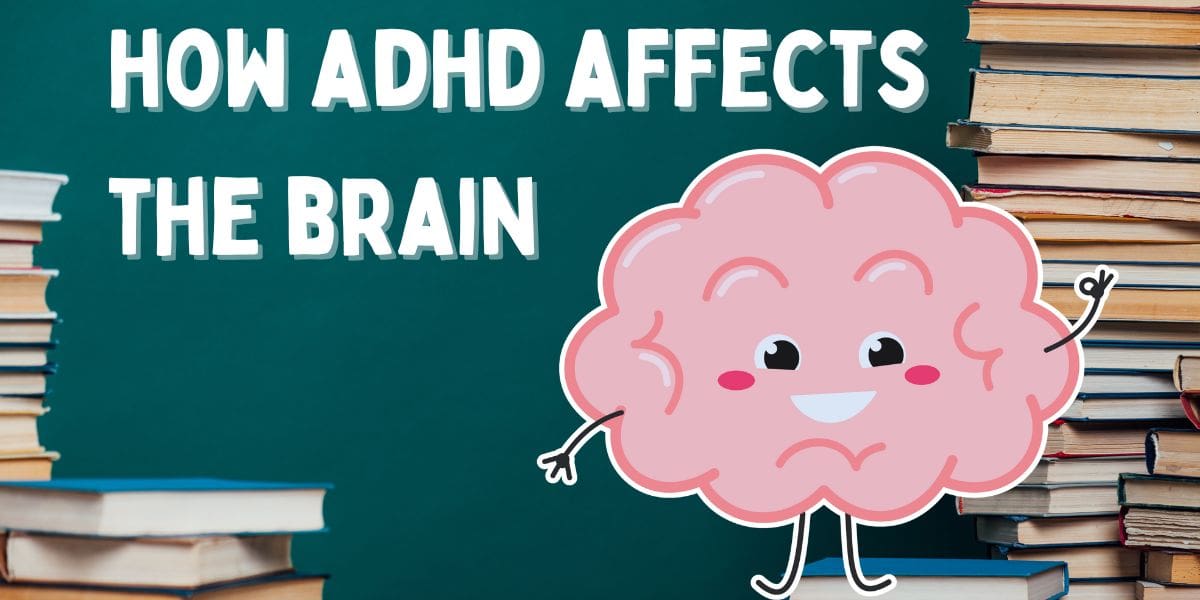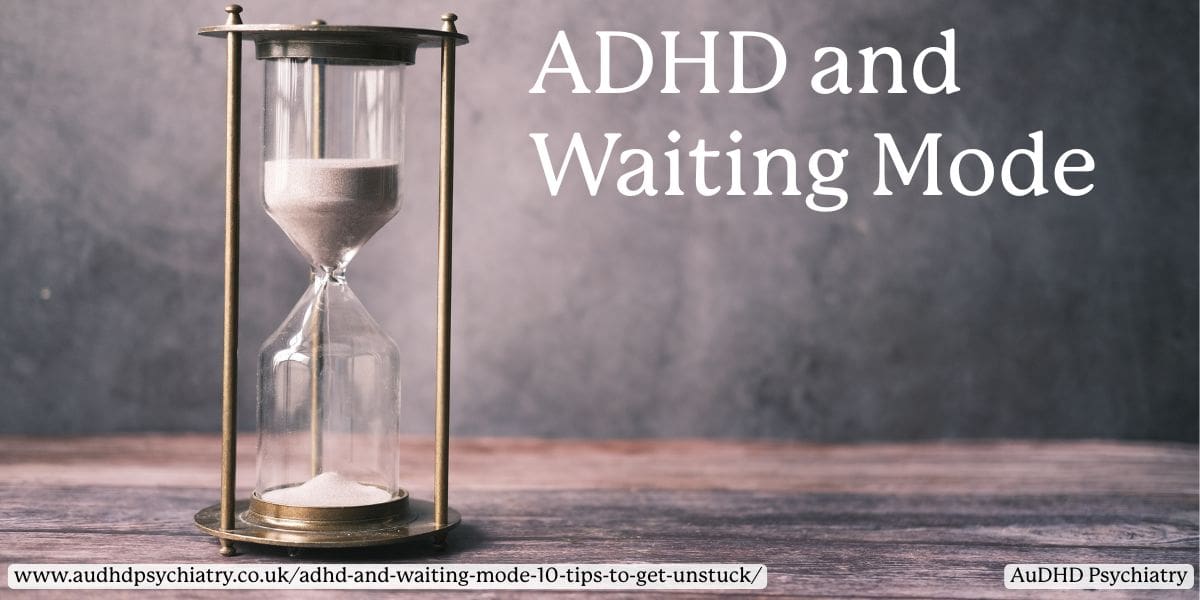Why do individuals with ADHD often struggle with focus, planning, or impulse control even when they’re trying their best? The answer isn’t about willpower. It’s about how ADHD shapes the brain.
ADHD affects the brain by altering its structure, chemistry, and function, especially in areas responsible for focus, impulse control, and emotional responses. As a neurodevelopmental condition, ADHD causes brain differences that affect daily life, from completing tasks to managing social interactions.
Research shows that the ADHD brain has smaller brain volume in key regions like the prefrontal cortex and basal ganglia. These structural differences explain common ADHD symptoms such as inattention, hyperactivity, and poor time management. Functional changes also disrupt brain networks responsible for executive functions and decision-making.
Understanding how ADHD works neurologically helps explain why it’s more than just a behavioural issue. It’s a medical condition well-documented by decades of brain imaging and cognitive studies.
In this guide, we’ll explore how ADHD impacts brain development, chemistry, and activity and what this means for treatment, support, and daily functioning.
Understanding How ADHD Affects the Brain
ADHD, or attention-deficit hyperactivity disorder, is more than forgetfulness or restlessness. It’s a complex brain-based condition that affects how a person thinks, feels, and behaves. It changes how the brain processes information and regulates attention, emotion, and motivation.
There are three recognised subtypes of ADHD: inattentive, hyperactive-impulsive, and combined. Inattentive symptoms include daydreaming, disorganisation, and difficulty sustaining focus. The hyperactive-impulsive type is marked by fidgeting, impulsive decisions, and excessive movement. Most people have the combined type, experiencing traits from both.
So, what does ADHD do to a person? It disrupts daily activities by interfering with executive functions, such as planning, time management, and self-monitoring. These challenges are rooted in measurable changes to brain structure and function.
Despite misconceptions, ADHD has nothing to do with laziness or lack of willpower. With proper diagnosis, ADHD can be managed. Many individuals thrive through individualised strategies, support, and consistent treatment.
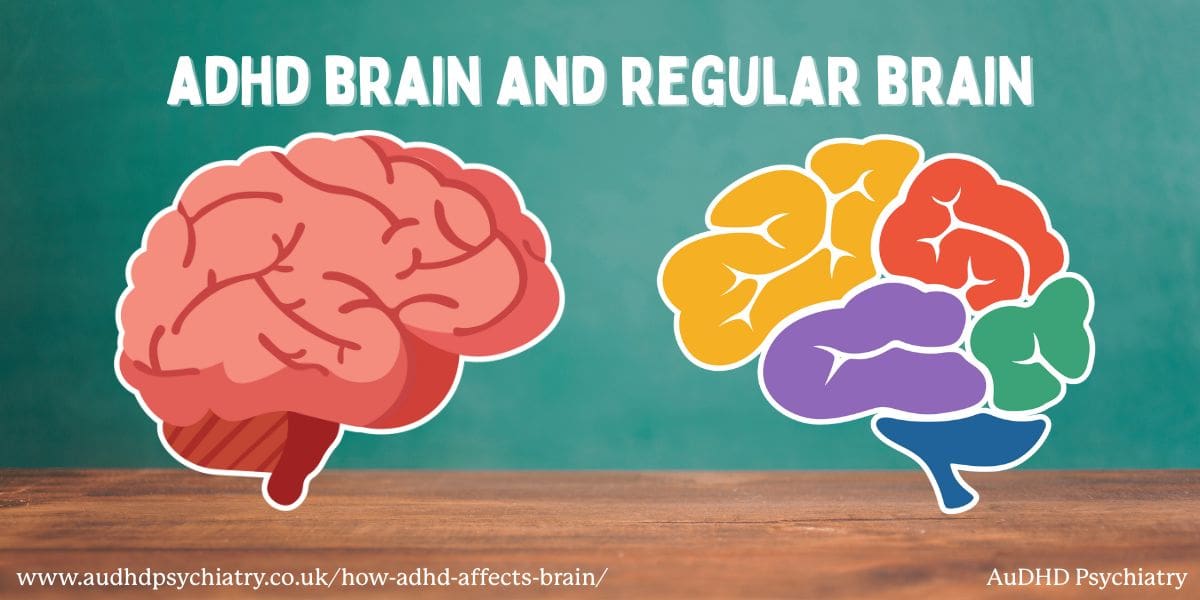
ADHD Brain vs. Regular Brain Differences
The ADHD brain differs significantly from a regular brain in both structure and function. These brain-based differences help explain the core symptoms of ADHD, such as inattention, impulsivity, and emotional dysregulation, and highlight why ADHD is more than a behavioural challenge.
Brain imaging studies consistently show that the ADHD brain vs. normal brain scan reveals visible differences in size, connectivity, and activity levels. These differences can impact attention span, reward processing, emotional regulation, and even motor control.
Understanding these changes gives us a clearer picture of how ADHD works in the brain and why standard behavioural advice often falls short without medical and therapeutic support.
Structural Differences in the ADHD Brain
One of the most notable differences is brain structure. Research shows that people with ADHD typically have smaller brain volume, especially in key regions such as the prefrontal cortex, basal ganglia, and cerebellum. These parts of the brain are in control of executive functions like planning, emotional control, and movement regulation.
Delayed brain development is also commonly seen in children with ADHD. Studies suggest that the ADHD brain development age can lag behind neurotypical peers by up to three years, especially in the frontal cortex, a region critical for decision-making and behavioural inhibition. These structural differences don’t mean the brain is damaged, but they do point to a different developmental trajectory that affects behaviour and learning.
Reduced volume in the basal ganglia affects the brain’s ability to filter out distractions and regulate responses to stimuli. Meanwhile, traditionally linked to movement, the cerebellum is now understood to play a valuable role in emotional and cognitive processing, which are areas often impaired in ADHD.
Understanding what causes ADHD in the brain is complex. Researchers believe a mix of genetic factors, environmental influences, low birth weight, brain injury, and chemical messenger imbalances like dopamine all contribute. However, one consistent finding is that structural abnormalities in these affected areas correlate strongly with ADHD symptoms.
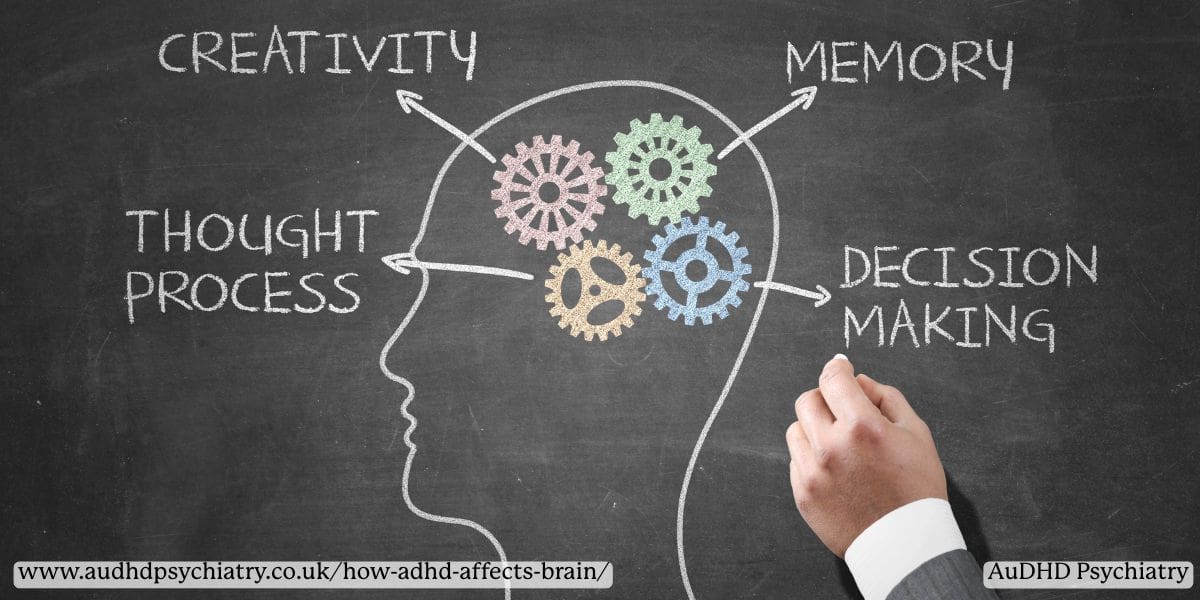
How ADHD Affects Daily Brain Function
One of the most well-documented neurological features of attention-deficit hyperactivity disorder (ADHD) is impaired executive functioning. Executive functions are higher-order cognitive abilities that regulate planning, decision-making, time management, self-monitoring, and goal-directed behaviour.
In individuals with ADHD, these processes are frequently disrupted due to structural and functional changes in specific brain regions we’ve previously discussed, particularly the prefrontal cortex and frontal lobe.
Research has consistently shown that individuals with ADHD demonstrate atypical activity in the neural circuits that govern executive functions. This disruption, often referred to as executive dysfunction, contributes to hallmark ADHD symptoms such as disorganisation, poor time estimation, difficulty initiating or completing tasks, and problems with impulse control.
These challenges are not the result of low motivation or effort but reflect measurable differences in brain function and functional connectivity.
The basal ganglia also exhibits structural and connectivity differences in the ADHD brain. These abnormalities impact behavioural inhibition and attentional control, making it difficult for individuals to prioritise tasks, regulate emotions, or shift focus adaptively. Collectively, this dysfunction across brain networks impairs one’s ability to manage complex or multi-step daily activities, from completing academic tasks to managing appointments and interpersonal relationships.
Rather than viewing ADHD as a lack of discipline or willpower, current neuroscience frames it as a condition arising from disrupted communication between brain areas responsible for goal-oriented behaviour. These differences have been visualised through various brain imaging studies, including fMRI scans that reveal hypoactivation in regions involved in cognitive control, particularly during tasks requiring sustained attention or delayed reward.
Executive dysfunction also has secondary impacts on mental health. Individuals with ADHD may experience chronic stress, reduced self-efficacy, and low self-esteem due to repeated difficulties meeting external expectations. These experiences can increase vulnerability to mood disorders and social withdrawal, underscoring the need for early and targeted intervention.
ADHD and the Brain’s Default Mode Network
The default mode network (DMN) is a major brain network active during wakeful rest, mind wandering, and internal thought. In neurotypical individuals, this network deactivates when attention shifts toward goal-directed activity. However, in people with ADHD, the DMN remains unusually active during tasks that require concentration, disrupting performance and contributing to lapses in attention.
Studies have shown that individuals with ADHD have greater functional connectivity within the DMN, as well as delayed suppression of DMN activity during cognitive tasks. This persistent activation is associated with inattentive symptoms, distractibility, and difficulty filtering out internal stimuli.
The result is a tug-of-war between being mentally “elsewhere” and trying to focus on the present task. Many individuals describe this experience as “zoning out,” losing track of time, or having difficulty staying engaged even with full awareness of the task’s importance.
These attentional lapses are not a sign of laziness. They reflect a measurable imbalance between competing neural networks.
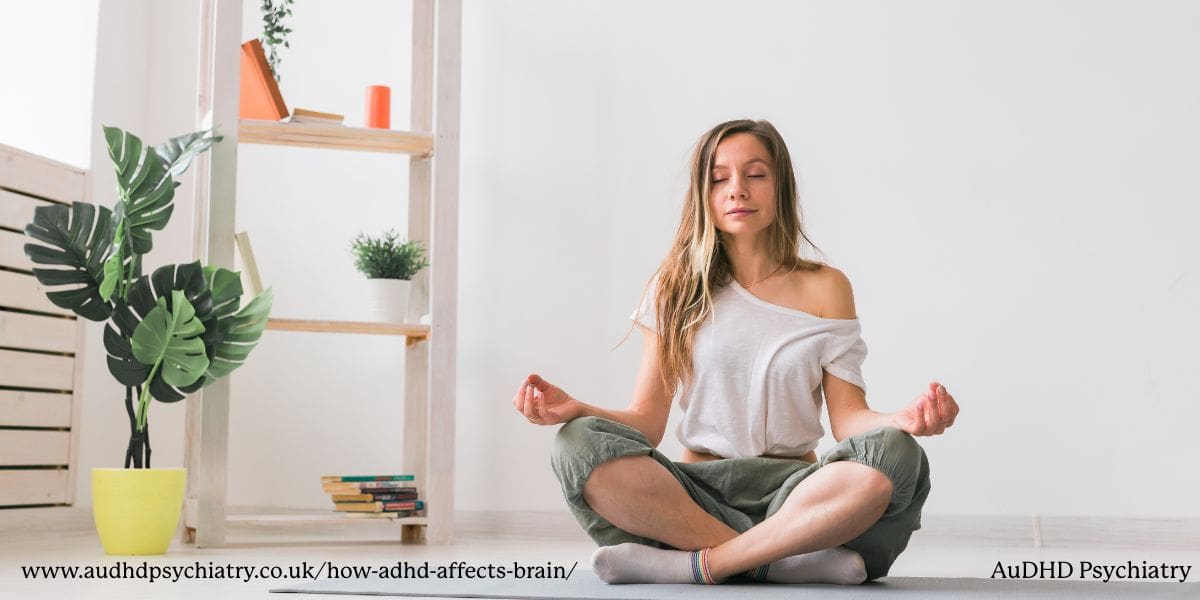
Overactivity in the DMN may also help explain ADHD’s unique relationship with emotional regulation and self-reflection. Since this network supports internal narrative and future planning, its poor regulation in ADHD may contribute to rumination, difficulty anticipating consequences, or challenges with self-monitoring.
Importantly, the DMN is not the problem on its own. The issue lies in the impaired coordination between the DMN and the brain’s task-positive systems, like the frontoparietal control network. This imbalance makes it hard to suppress internal thought when external attention is needed, and vice versa.
Emerging evidence suggests that interventions like mindfulness meditation, CBT, and certain ADHD medications may help regulate these networks more effectively. We’ll discuss these in-depth in later sections.
As researchers continue to uncover how brain networks in ADHD operate differently, these insights can guide more targeted treatment and support strategies. By addressing the root of attentional disruptions, rather than just their surface behaviours, we can better equip individuals with ADHD to succeed in work, school, and life.
Task-Positive Networks and Cognitive Control
The task-positive networks, especially the frontoparietal control network, are essential for attention control, working memory, and staying focused on goals. These brain networks help regulate mental resources and shift focus as tasks change.
In individuals with ADHD, these networks show reduced activation during tasks that demand sustained attention, planning, or problem-solving. This underactivation, particularly in the dorsolateral prefrontal cortex, limits cognitive flexibility, task initiation, and persistence on long-term goals.
An imbalance between task-positive systems and the default mode network may explain ADHD’s inconsistent attention patterns. For example, people with ADHD may hyperfocus on engaging tasks but struggle with routine responsibilities. This pattern reflects not a lack of motivation but disrupted brain activity and network coordination.
ADHD Brain Chemistry
One of the core neurological factors behind ADHD is an imbalance in key brain chemicals, particularly dopamine and norepinephrine. These ADHD neurotransmitters help regulate focus, motivation, and behaviour. These chemical messengers regulate motivation, focus, and impulse control, and disruptions in their function significantly contribute to ADHD symptoms.
In individuals with ADHD, studies show lower levels of dopamine in critical brain areas such as the prefrontal cortex, and limbic system, and including the basal ganglia. These regions are responsible for executive functions, emotional regulation, and task persistence. When dopamine signalling is reduced, the brain struggles to prioritise effort toward tasks that lack immediate reward, contributing to challenges with time management, delayed gratification, and staying organised.
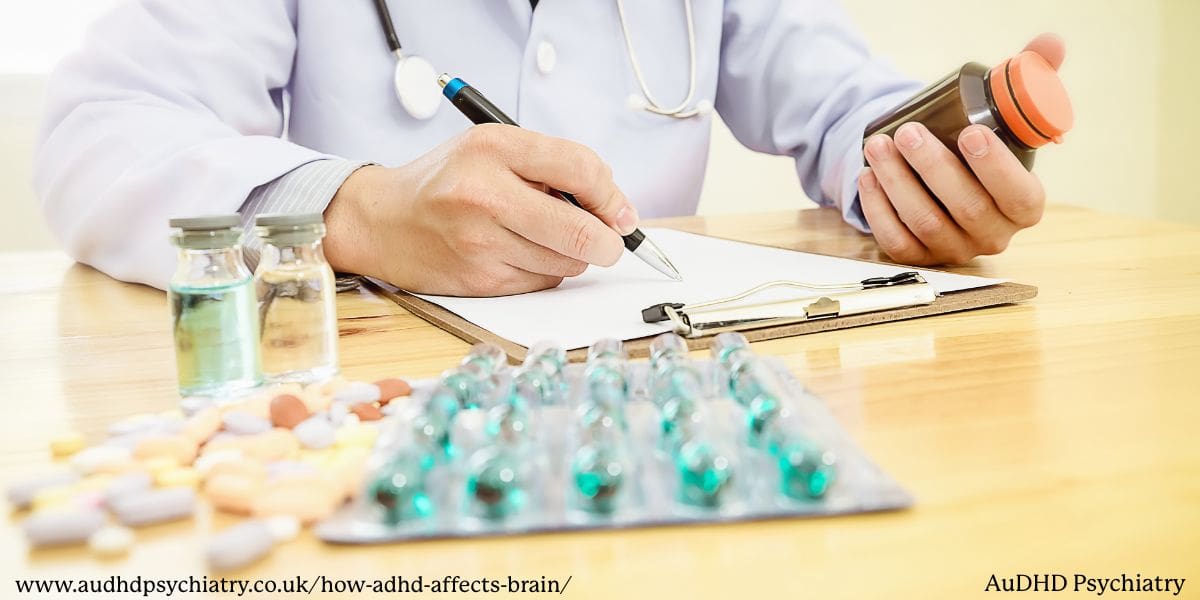
How Does ADHD Medication Work?
ADHD medications, particularly stimulants like methylphenidate and amphetamines, target these deficits by increasing dopamine and norepinephrine levels. This enhances brain function by improving the efficiency of neural networks related to attention and cognitive control. These stimulant medications help normalise brain activity, especially in areas responsible for working memory and goal-directed behaviour.
Over time, treatment can support better daily functioning and reduce impairments in social interactions, academic performance, and mental health. Overall, ADHD medication effects include improved attention span, emotional stability, and enhanced engagement with tasks that previously felt overwhelming.
ADHD Brain Imaging and What It Reveals
Advancements in brain imaging, including fMRI and PET scans, offer a clearer picture of how ADHD changes the brain structurally and functionally. When comparing the ADHD brain vs regular brain, researchers consistently observe smaller brain volume in areas such as the frontal lobe, cerebellum, and caudate nucleus: all of which play a key role in attention regulation, decision-making, and movement coordination.
These scans also reveal delayed brain development, especially in the frontal cortex of children and young adults with ADHD. This delay can impact the development of executive functions and self-regulation well into adolescence.
Functionally, imaging highlights reduced activity in the task-positive networks and overactivity in the default mode network, reinforcing the neurological basis for distractibility, inconsistent attention, and difficulty switching between tasks. Altered functional connectivity between these brain networks supports the view of ADHD as an imbalance of neural regulation rather than a simple behavioural issue.
While brain imaging is not used for clinical ADHD diagnosis, it provides compelling evidence of consistent brain differences, guiding healthcare providers in delivering evidence-based ADHD treatments.
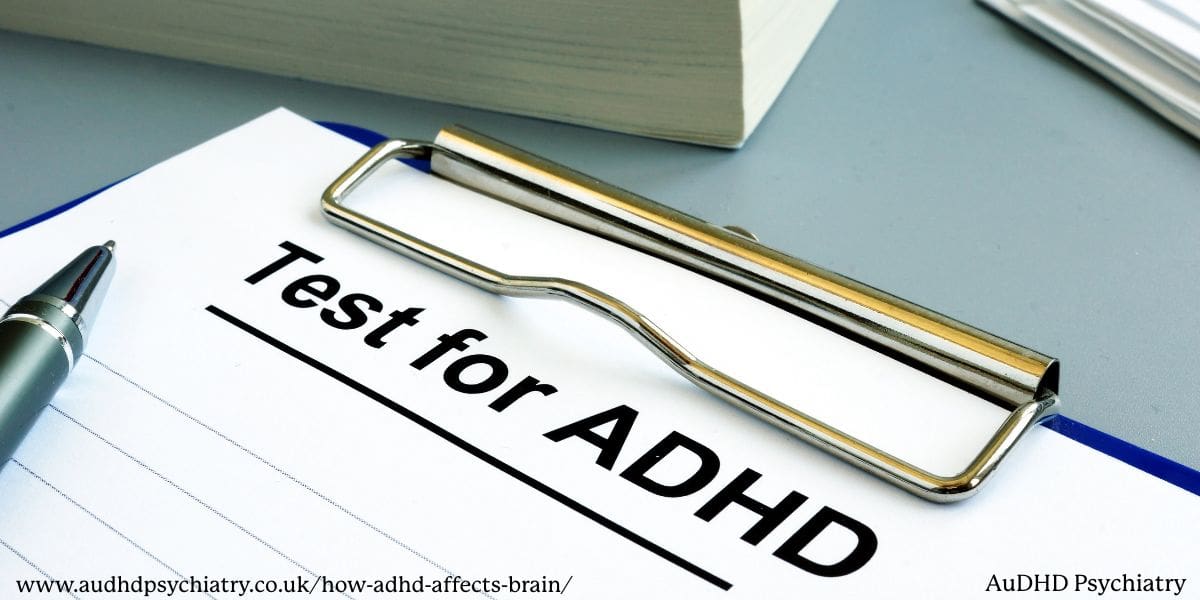
Diagnosing ADHD and What It Means for the Brain
An ADHD diagnosis is based on clinical criteria, not brain scans. Health care providers use guidelines from the Diagnostic and Statistical Manual of Mental Disorders, Fifth Edition (DSM-5) to assess behavioural symptoms such as inattention, impulsivity, and hyperactivity. While brain imaging has shown consistent patterns of structural and functional differences in ADHD, these tools are not yet used for diagnosis due to variability across individuals.
However, the science is clear: ADHD has a strong neurological basis. Decades of neuroimaging and cognitive research have confirmed that ADHD is a legitimate brain-based diagnosis, not a matter of willpower or poor parenting. The structural abnormalities in the prefrontal cortex, basal ganglia, and cerebellum we’ve discussed, along with imbalances in chemical messengers like dopamine, provide measurable evidence of neurological disruption.
If you or someone you know is experiencing symptoms, the first step to getting tested for neurodivergence is to seek help from an ADHD specialist or qualified healthcare provider. A comprehensive evaluation may include symptom checklists, interviews, and attention tests. Before a formal assessment, you can begin with our free ADHD screening test.
Is the ADHD Brain Really Wired Differently?
Yes, the ADHD brain is wired differently. This phrase captures the distinct way individuals with ADHD experience the world. Scientific evidence supports the presence of structural differences, neurotransmitter imbalances, and disrupted brain networks, particularly those involved in executive functions and cognitive control.
Rather than viewing these traits as deficits, healthcare professionals and researchers reframe them as natural variations in human cognition. ADHD may cause difficulties in some environments, but it also brings strengths such as creativity, spontaneity, and hyperfocus in areas of high interest.
Recognising how ADHD affects the brain allows for more targeted interventions and reduces the stigma associated with the condition. Understanding neurodiversity can also help educators, families, and employers build better support systems, emphasising the importance of individualised approaches rather than one-size-fits-all strategies.
Can ADHD Treatment Change Brain Function?
Yes, research shows that ADHD treatment can positively influence brain function, leading to symptom reduction, especially when started early. Both ADHD meds and behavioural therapy have been shown to enhance cognitive functions and improve functional connectivity between major brain networks.
Stimulant medications such as methylphenidate affect dopamine transporters, improving signal transmission in areas responsible for attention and self-regulation. Over time, these medications help normalise brain activity, supporting better performance in daily activities and academic or work settings.
Note that for some, ADHD medication weight loss can also occur, particularly with stimulant-based treatments that suppress appetite. Early and consistent intervention may even support more typical patterns of brain development. This highlights the importance of timely support, especially for young adults and children.
To learn more about ADHD and medication options, including side effects and costs, see our guide on ADHD Medication in the UK.

Therapy and Brain-Based Coping Strategies
While stimulant medication remains a frontline intervention for ADHD, many individuals also benefit from ADHD therapy focused on long-term cognitive and emotional regulation. These therapeutic approaches leverage the brain’s capacity for change, known as neuroplasticity, to build new habits, develop coping strategies, and improve functional outcomes in daily life.
Cognitive behavioural therapy (CBT) is one of the most widely recommended forms of ADHD therapy. CBT helps individuals recognise and reframe unhelpful thought patterns, manage emotional responses, and establish practical skills for task initiation, time management, and organisation. Studies show CBT can significantly reduce symptoms by strengthening awareness and behavioural control, especially when used alongside medication.
Mindfulness-based interventions are another emerging area in ADHD treatment. These practices train the brain to remain focused on the present moment, reducing mind-wandering associated with default mode network overactivity. Mindfulness has been shown to enhance attention regulation, decrease impulsivity, and reduce emotional reactivity by engaging brain networks responsible for executive functions and emotional processing.
Behavioural coaching also plays a supportive role, especially for adolescents and adults. ADHD coaches provide structured guidance and accountability to help individuals stay on track with goals, routines, and problem-solving strategies. These coaching relationships foster skill development in real-world contexts, often improving outcomes in education, work, and personal relationships.
What makes these brain-based strategies for ADHD effective is their alignment with how the ADHD brain works. Rather than trying to suppress symptoms through discipline alone, therapy targets specific brain functions and builds cognitive flexibility. These interventions work with the brain’s natural learning processes, strengthening neural pathways through repetition, feedback, and adaptive learning.
Recent advances in neuroscience have shown that neuroplasticity and ADHD are closely linked. Individuals with ADHD may show delayed brain maturation, but the brain remains capable of change well into adulthood. This adaptability makes therapeutic interventions especially valuable not just for symptom relief, but for improving quality of life and resilience over time.
Brain training tools and digital programs are also becoming more common in ADHD therapy. These platforms challenge working memory, response inhibition, and sustained attention using gamified tasks.
While evidence varies by program, some studies show that cognitive training may improve certain domains of executive function, particularly when combined with other treatments. For additional resources to support daily life with ADHD, including study tools, focus aids, and apps, check out our curated list of ADHD resources and tools.
Ultimately, the most effective ADHD treatment plans combine evidence-based therapy with appropriate medication, environmental supports, and individualised strategies. This holistic approach acknowledges that ADHD is not simply a behavioural issue, but a neurological condition that benefits from targeted, brain-aware interventions.
How ADHD Affects the Brain: Conclusion
Understanding how ADHD affects the brain has advanced significantly in recent years, giving us a clearer picture of the condition’s neurological foundation. From differences in brain structure and size to disrupted chemical messengers and altered connectivity across major networks, the ADHD brain functions in distinct, measurable ways. These differences impact attention, executive functions, emotional regulation, and behaviour in daily life.
Science confirms that ADHD is not a failure of effort or discipline. Iit is a neurodevelopmental disorder with valid, observable changes in brain function. Brain imaging, cognitive research, and clinical studies have repeatedly shown how ADHD manifests in areas like the prefrontal cortex, basal ganglia, and default mode network.
These findings continue to shape ADHD brain treatment approaches that are grounded in neuroscience and focused on individual needs. Most importantly, the ADHD brain is highly responsive to support.
Through a combination of tailored strategies, therapy, and medication, individuals with ADHD can experience meaningful improvements in focus, emotional resilience, and quality of life. Brain-based ADHD support empowers individuals to work with their brain, not against it, making long-term success not just possible, but sustainable.
If you’re exploring support for ADHD symptoms or seeking help for someone you care about, our team can help you receive 32an accurate diagnosis. Book a private ADHD Assessment with us and explore a full spectrum of strategies built on how the ADHD brain truly works.

